The Sandy Bridge Preview
by Anand Lal Shimpi on August 27, 2010 2:38 PM ESTAdobe Photoshop CS4 Performance
To measure performance under Photoshop CS4 we turn to the Retouch Artists’ Speed Test. The test does basic photo editing; there are a couple of color space conversions, many layer creations, color curve adjustment, image and canvas size adjustment, unsharp mask, and finally a gaussian blur performed on the entire image.
The whole process is timed and thanks to the use of Intel's X25-M SSD as our test bed hard drive, performance is far more predictable than back when we used to test on mechanical disks.
Time is reported in seconds and the lower numbers mean better performance. The test is multithreaded and can hit all four cores in a quad-core machine.
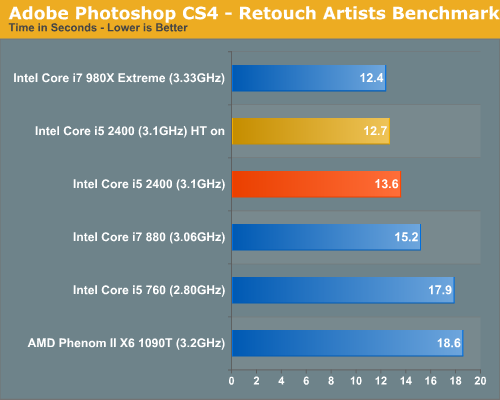
Right off the bat Sandy Bridge is killer. In our Photoshop test it’s faster than its closest quad-core price competitor, faster than its identically clocked Lynnfield, faster than AMD’s fastest and loses out only to Intel’s $999 Core i7 980X. That being said, it only takes about 9% longer to complete our benchmark than the 980X.
DivX 6.5.3 with Xmpeg 5.0.3
Our DivX test is the same DivX / XMpeg 5.03 test we've run for the past few years now, the 1080p source file is encoded using the unconstrained DivX profile, quality/performance is set balanced at 5 and enhanced multithreading is enabled:
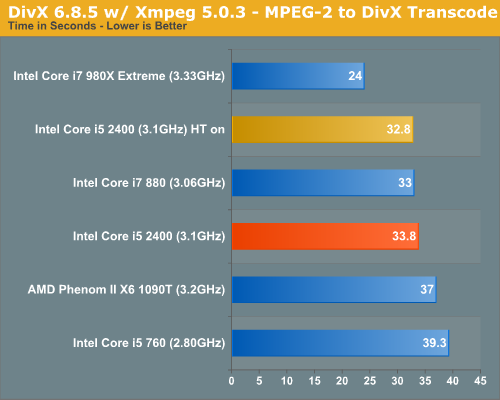
While not the most stressful encoding test, it’s still a valid measure of performance and once again, Sandy Bridge is faster than all. In this case we’re faster than the Core i5 760 (~16%) and just behind the Core i7 880. Clock for clock there's not a huge improvement in performance here (HT doesn't seem to do much), it's just a better value than the 760 assuming prices remain the same.
x264 HD Video Encoding Performance
Graysky's x264 HD test uses the publicly available x264 encoder to transcode a 4Mbps 720p MPEG-2 source. The focus here is on quality rather than speed, thus the benchmark uses a 2-pass encode and reports the average frame rate in each pass.
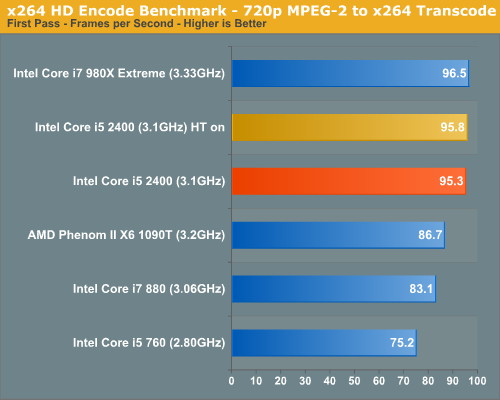
Lightly threaded performance is much improved - the 2400 is 14.6% faster than the Core i7 880.
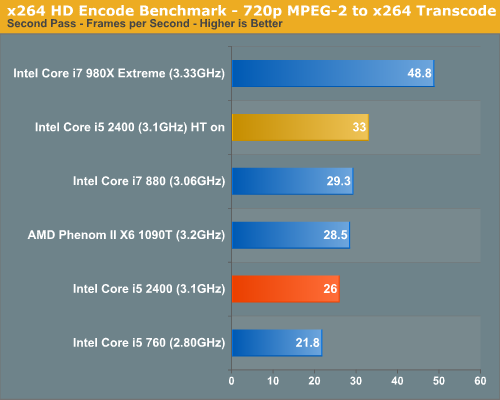
The actual encoding pass favors more threads, so we see a big improvement over the 760 (19%) but it falls short of the Core i7 880. Turn HT on and we get a 12.6% improvement over an identically clocked/configured Lynnfield.
Note that CPU based video encoding performance may not matter if Intel implemented a good video transcode engine in Sandy Bridge.
Windows Media Encoder 9 x64 Advanced Profile
In order to be codec agnostic we've got a Windows Media Encoder benchmark looking at the same sort of thing we've been doing in the DivX and x264 tests, but using WME instead.
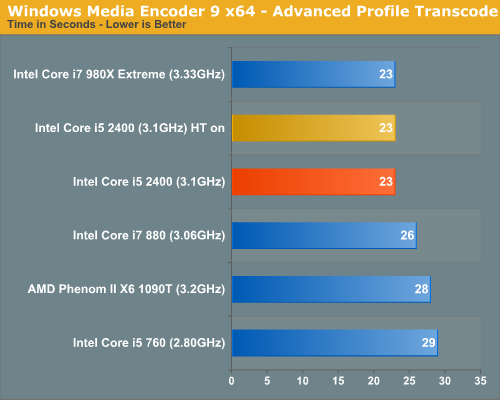
Performance in WME rarely scales anymore. Our benchmark doesn’t scale well beyond 4 cores and the only hope for performance are increases in clock speed or IPC. Sandy Bridge delivers the latter.
A 20% increase in performance vs. the similarly clocked 880 in a test that doesn’t scale with anything but IPC tells you a lot. Compared to the Core i5 760, Sandy Bridge is 26% faster.










200 Comments
View All Comments
DrRap - Friday, August 27, 2010 - link
It's Anand "intel" lal Shimpi.Anand Lal Shimpi - Friday, August 27, 2010 - link
I agree that single threaded performance is important to keep in mind. Sandy Bridge had a larger ILP boost than I expected. Final silicon with turbo enabled should address that even more.We got into trouble chasing the ILP train for years. At this point both AMD and Intel are focused on thread level parallelism. I'm not sure that we'll see significant ILP gains from either party for quite a while now.
The socket move is silly, unfortunately there's nothing that can be done about that. AMD takes better care of its existing board owners, that's something we've pointed out in prior reviews (e.g. our Phenom II X6 review).
I'm not sure I'd call Sandy Bridge a kiddie chip however. It looks like it'll deliver great bang for your buck when it launches in Q1 regardless of how threaded your workload is.
Value scatterplots are a great idea, Scott does a wonderful job with them. We're going to eventually integrate pricing data with Bench (www.anandtech.com/bench) which should help you as well :)
Take care,
Anand
ssj4Gogeta - Saturday, August 28, 2010 - link
I'm guessing USB 3.0 support will be introduced later with a chipset upgrade. Why are you so concerned with GHz when Sandy Bridge delivers more IPC? I think having better IPC instead of more GHz is better as you'll get potentially lower power consumption.asmoma - Friday, August 27, 2010 - link
Lets just hope AMD trhows in 80 gpu cores into ontario to bring this SB igp to shame(almost the same performance but less than 10w tdp). And lets also hope they throw in those 400 cores into Llano we have been hearing about.mfago - Friday, August 27, 2010 - link
Any news on OpenCL support? I image Apple may hold off on a purely integrated GPU unless that is supported.Thanks!
Anand Lal Shimpi - Friday, August 27, 2010 - link
Sandy Bridge's GPU does not support OpenCL. This is strictly a graphics play, Intel doesn't have an announced GPU compute strategy outside of what it's doing with Larrabee.Take care,
Anand
DanNeely - Friday, August 27, 2010 - link
Is intel actually still doing anything with Larrabee on the gfx side? I thought they killed it on that end entirely and were looking at it strictly as a compute platform now.Anand Lal Shimpi - Saturday, August 28, 2010 - link
Correct - as of today the only Larrabee parts are for the HPC market. Didn't mean to confuse there :)Take care,
Anand
JonnyDough - Friday, August 27, 2010 - link
"Correction, you'll be able to buy it next year, but you'll get to meet her today."Sandy could be a boy too!
JonnyDough - Friday, August 27, 2010 - link
By the way, is it a an it, or a girl? You can't have it both ways!